Forum Replies Created
-
AuthorPosts
-
 Bill WardParticipant
Bill WardParticipantWas it? Maybe I’m just too slow…
 Bill WardParticipant
Bill WardParticipantFinally inspiration!
As my old apprentice master would say “…aye, experience, one thing ye canny buy in the shops…” and how true..
Having obtained several more very high resolution spectra of varying kinds it suddenly occurred to me what was going on with this one.
I was also pretty sure that there was an order division but as I was expecting the distinct pattern of atmospheric near IR emissions toward the right of the spectrum, the lines present threw me off track a bit, However your division there was spot on. The issue seems to have been I bumped the focus! When this image is compared to my later ones it is clear this is the case.
Also, one of the other secondary pieces of information that can be gleaned from the spectrum image is that since the 2nd order are so clearly present it indicates that the meteor must have been a slow one. (As well as being rich in Fe lines!) Otherwise these lines would have been overlaid or masked by the pattern of near IR emissions from the atmosphere.
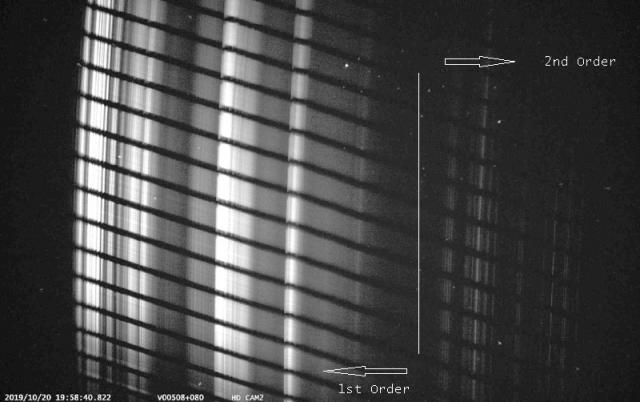
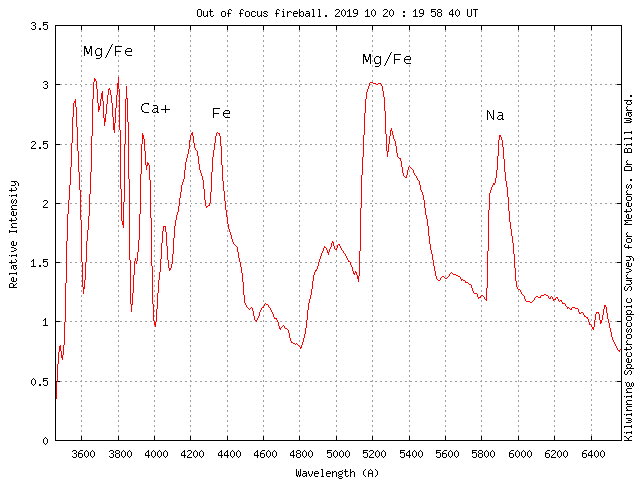
A bit rough and ready but it now all makes sense. Another mystery finally resolved!
Cheers,
Bill.
 Bill WardParticipant
Bill WardParticipantI certainly hope there’s more than just a shadow of our bones left ; – )
 Bill WardParticipant
Bill WardParticipantHi,
ahhh, I meant “secondary” as in some sort of corrector not a secondary mirror… Even a “perfect” mirror will exhibit some aberrations at f2. Something to stretch it out to f4 maybe, a barlow lens basically, then the camera. I’ve got boxes of lenses to play with that I’ve accumulated over the years. However I have a small fibre fed Littrow spectroscope I built a while back sitting in a drawer. It needs a bit of tlc but offers interesting possibilities. Ultimately the mirror might just become a flux collector rather than a “telescope”, no need to worry about imaging quality then. The next problem is a suitable mount, it is a chunky piece of glass…
It’s all good fun!
Bill.
 Bill WardParticipant
Bill WardParticipantHi, Grant/Eric,
thanks for the comments. I’ve used Galvoptics before but they, like Scientific Mirrors are a bit too far south for an easy drive. I’m a regular visitor to Manchester so Orion is not to much further down the M6. I’m always nervous when it comes to shipping big optics. Couriers will promise the earth but “…it fell off the forklift…” has happened to me before!
cheers,
Bill.
 Bill WardParticipant
Bill WardParticipantHi,
Thanks all for the various comments. I don’t think I’ll be opting for any fancy coatings as I don’t know how good the mirror actually is nor how I’ll be able to fully exploit such a fast mirror without other aberrations being corrected.
Even if the figure isn’t that good, plain aluminium will do to let me play around with secondary optics with at least usable results.
Might be the worlds shortest dobsonian… ; – ))
I’ll keep you posted!
cheers,
Bill.
 Bill WardParticipant
Bill WardParticipantHi Eric,
LOL, Exactly! I had just returned to Uni when it came out. My first copy, which was the hardback version, fell to pieces I used it so much. Currently have a paperback copy and also not for sale ; – ))
Indeed, this one seems to cover the more modern digital side of things but a lot of it seems to be optics and personal profiles which I’m not so into, got far too many books on optics and telescope design!!!
It’s looks like and updated take on the Solar Astronomy Handbook by Beck, Hilbrecht, Reinsch and Volker (Willamann Bell 1995). Also excellent but with the sad demise of Willmann Bell probably only available second hand, although some dealers may have a new copy or two…
I think I’ll give this one a miss at the moment but I think I’ll go and have a wee peek, suitably filtered of course, at the sun this afternoon while the sky is clear(ish)
Cheers,
Bill.
 Bill WardParticipant
Bill WardParticipantHi,
Looks interesting… I may be preaching to the converted, as the saying goes, but for me the solar bible will always be Astrophysics of the Sun by Harold Zirin.
First printed in 1988 by CUP, re-printed 1989, it’s a bit dated but it is an excellent science foundation, graduate level but with much for the knowledgeable amateur. Only available second hand now and it seems to be sought after, some of the recent prices I’ve seen are very steep! However If you come across a decent copy at a reasonable price then I’d recommend buying it.
Cheers,
Bill.
 Bill WardParticipant
Bill WardParticipantHi,
The devil is in the detail, as they say.
There are definite lines visible longward of the sodium line in the first spectrum plot here and closer inspection reveals quite a few more.
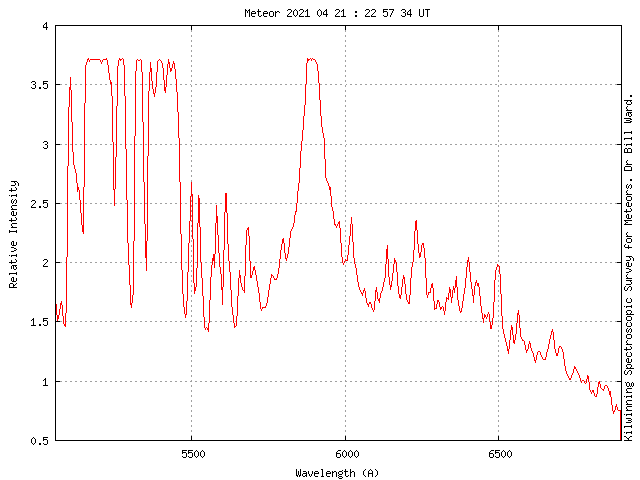
With some stretching there are some 17 “real” lines just above the noise in the original image. I’m still trying to identify these. I’m confident some are W but as for the rest….
There are a few lines in this part of the spectrum in a lot of spectra I’ve captured. I’ve attributed these to weak Fe and Ca but I’ve never captured so many others. The relatively slow velocity of this meteor might be revealing some very interesting features. Work done by Jiri Borovicka on what he calls “the orange band” indicates that some of these line may actually be oxides. This will take more study but this is by far the most interesting spectrum I’ve captured.
Cheers,
Bill.
 Bill WardParticipant
Bill WardParticipantHi,
That is a super result. Well done everyone!
I’m glad my guesstimate about the Vg was correct ; – )
One of those “secondary” results that a spectrum can reveal…
Cheers,
Bill.
PS
I had a look at what Ed sent me in 2019. He says he estimated that the meteor was -4, also very similar to the -3 here. Yep, this is an interesting one…
 Bill WardParticipant
Bill WardParticipantWhilst processing the spectrum I had a funny feeling that this looked familiar somehow….
Couldn’t quite put my finger on it, then I got it!
A while back I was asked to look at, what was then a mystery spectrum, taken by Ed Majden in June 1997 from Canada.
A little cropping to give a better comparison. This is the flare section from the meteor last night.

…and this is Ed’s spectrum from 1997, also cropped on one of the flares…

Remarkably similar morphology!
 Bill WardParticipant
Bill WardParticipantHi,
Looking at the radio plots the predicted time of the peak from the graphs looks to be pretty good!
Overall activity seemed to be quite low this year. Didn’t record a single confirmed Lyrid spectrum. However I did record a super spectrum from what is looking like a sporadic (Although this may change, Alex et al have started to analyse the orbit…)
I recorded the meteor on several systems.
This is the zero order image on one of the ZWO cameras:
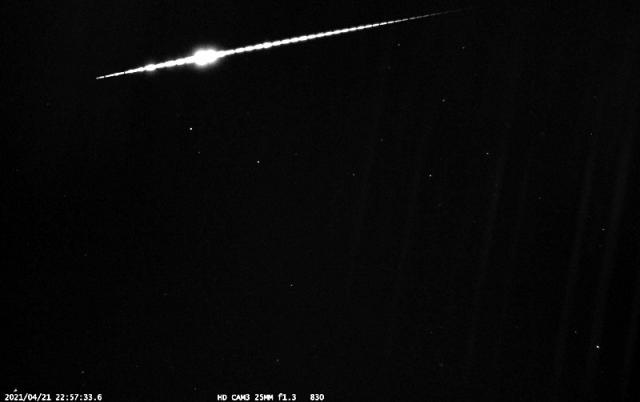
The spectrum from another ZWO camera:
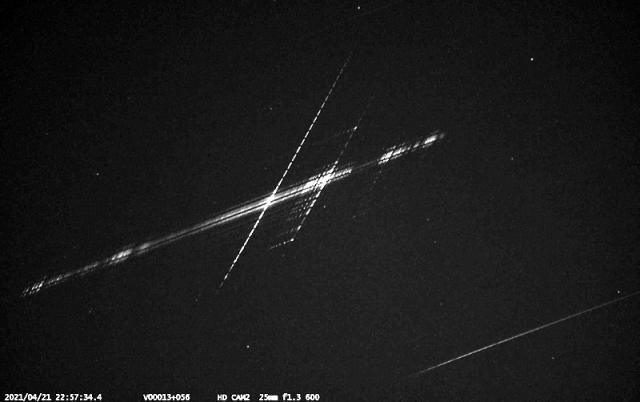
An instrument corrected plot:
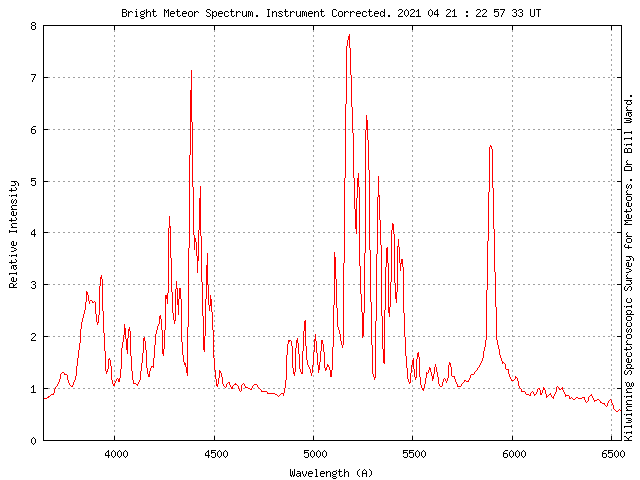
…and finally my usual colourised synthetic spectrum…

The “longest” line in the spectrum image is sodium, very strong, but also very strong emission from Mg and plenty of Fe lines.
Little or no near IR atmospheric lines so probably relatively slow Vg, interestingly, and as as a possible consequence of the low Vg there are no (or very weak) ionised Ca on ionised Mg lines.
Not a Lyrid but lovely!
Cheers,
Bill
 Bill WardParticipant
Bill WardParticipantHi,
Thanks Philip, It’s taken 6 years to get a weather break for the QUA’s here too! The HD video cams have produced some exceptional results this year! I’m slowly becoming intimately aware of all little bumps and wrinkles of each shower. The Quadrantids really do have a strong Mg signature, even in the near UV the broad feature is an unresovled Mg triplet.
Whilst reviewing my Narrow Field of View Experiment I noted that most of the QUA’s seemed to have a very uniform light profile, both radially and axially. I’ve put a video on YouTube showing this. https://youtu.be/c8HP1V-5Eik
Cheers,
Bill.
 Bill WardParticipant
Bill WardParticipantHi all,
Despite the usual cloudy, wet and windy weather throughout the year a few brief spells gave me some excellent results.
My use of the ZWO 174 cameras has proved very successful inasmuch as they have produced some of the best meteor spectra ever recorded (either amateur or professional). Both surprising and pleasing!!!
As meteor astronomy is fairly dynamic most of my results have been posted here then summarised in The Astronomer.
2021 has already got off to a super start, I even received a very complementary response to a tweet about the spectrum from just yesterday. Josep M Trigo, one of the worlds leading meteor astronomy experts said that my spectrum was better that what he had in his books!
Clear skies.
Cheers,
Bill.
2 January 2021 at 2:56 am in reply to: Detection leading to continuous recordings with UFO Capture #583629 Bill WardParticipant
Bill WardParticipantHi,
There was some correspondence on the nemetode.io group (which I heartily recommend you join) about peculiar captures…
Are you using Windows 10 by any chance…?
If so, the conclusion, after exhaustive tests just like you describe, seemed to be to change to win 7 or even XP. I have systems using both these operating systems for over 10 years and they’ve never hiccuped. I’m not an expert and I don’t know why but Windows 10 does seem to have some issues.
That may be the main issue but I could also add, from experience, stick to onboard hard drives, using external ones seems to cause problems with recording. Mine was/is a western Digital USB3 model and it just didn’t seem happy…
Not much of a solution but I hope it helps.
Cheers,
Bill.
 Bill WardParticipant
Bill WardParticipantHi,
Yes, definitely increased activity but I didn’t see the huge numbers forecast…
I was surprised that the night was mostly clear, started off sparkling then got a bit foggy before clearing to higher broken cloud. Well pleased with this one.
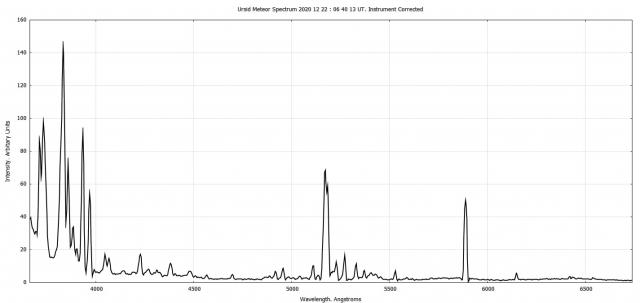

A nice rocky piece of comet dust, got most lines figured out but as usual a few of the weaker ones are the mysteries, could be any of several metals… I was surprised to see faint emission at 557.7nm, this is usually the preserve of faster meteors, could be related to the size of the meteoroid…?
The others I got were at: 025040, 034541, 054702, 234653, 001036, 032239
All of these were MUCH fainter than the 0640 one!
It’s always seen as a lowly shower but it’s the one that started me on video analysis path.
In my own attempt to replicate the Brandes and Benzenberg experiment of 1798…
 This was captured on video tape!
This was captured on video tape! Using UFO Capture.
Using UFO Capture. Two pairs of Ursids and where the two stations were. The height worked out by hand as 109km, +/- a lot!!! ; – )))
Two pairs of Ursids and where the two stations were. The height worked out by hand as 109km, +/- a lot!!! ; – )))2007, a full moon and me and Tom McEwan freezing at the Beith Golf Club Car park during a previous “outburst”, Happy Days!
Cheers,
Bill.
 Bill WardParticipant
Bill WardParticipantMike,
Where do I find “Stop Updates 10″….? My excursions in the various settings/options/advanced options have failed to reveal to me such a function. I can find notify and delay options, updating all sorts of functionality individually but nothing that actually stops the updates completely.
Your help would be appreciated.
Bill.
 Bill WardParticipant
Bill WardParticipantHi Tracey,
I know what you mean, I’ve not had my system on for months, gave up with auto updates shutting down my machine…
It’s intriguing listening to the pings, that was the only reason I put it on! The longest ping I recorded this time was about 1 minute. I too was surprised by the fall off in activity as it does normally climb as the geometry improves in combination with the radiant rising. … but predictions are just that…
You tend to get longer echoes with higher velocity meteors (Perseids and Leonids) since they dump at lot more energy into the atmosphere per unit mass.
I don’t know if it’s still available but the IMO Radio workshop/handbook proceedings is a good review of radio observations.
The SDR dongles have certainly made the hardware less expensive. I’ve used a couple in various set ups over the past few years but my old ham radio set still seems to be the best performer!
I’ll probably shut it down after the Quadrantids…
Mike, what antennae were you experimenting with? I’ve been using a 4 element for over a decade at my current location. Longer antenna haven’t really improved the situation much (Beamwidth/gain compromises) but have toyed with the idea of constructing an old fashioned full wavelength co-linear array. I found the change from horizontal to vertical polarisation significant. Yagis may be better for comms but I think when it comes to meteor observing there are different issues…
Cheers,
Bill.
 Bill WardParticipant
Bill WardParticipantHi,
Had a quick look at my HROfft images and 2320 seems to have been the 10 min interval with the highest activity!
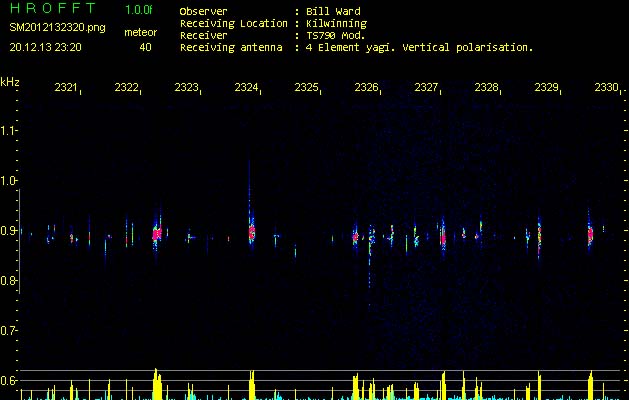
Lots of meteors! : – 0
I did have one frame with 46 meteors but it also had some interference that might have bumped to count up a little.
Here’s a higher temporal version with the big ping just after 2322…
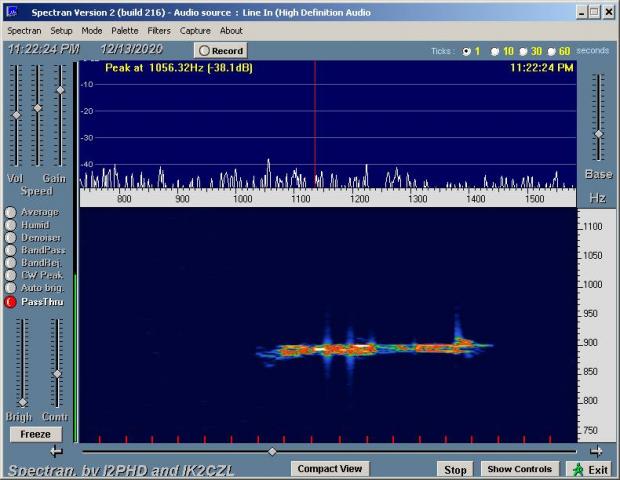
The red tick marks at the bottom are at 1 second intervals.
It’s all good fun.
Cheers,
Bill.
 Bill WardParticipant
Bill WardParticipantHi,
Looks good! I also noticed the enhanced activity around 22-23hr. The traditional peak seems to have been down a bit compared to that hour. ~200+/hour compared to ~160/hour in the morning hours.
I set up the screen capture in SPECTRAN to see how the activity would develop.
Here’s a radio “movie” of six hours worth of activity from this morning. https://youtu.be/9xQ_CvAXWGA
Cheers,
Bill.
-
AuthorPosts
